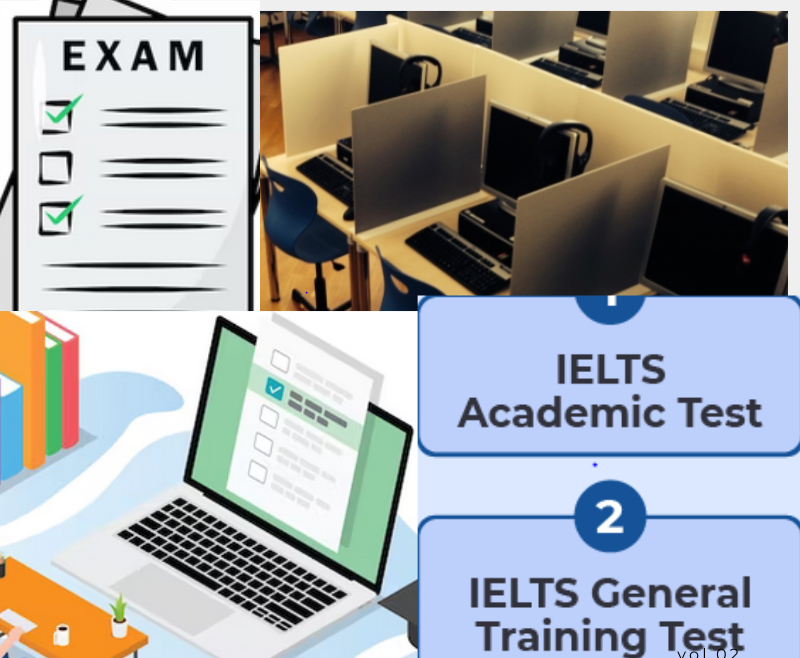IELTS (International English Language Testing System) tests your English proficiency with four components: Listening, reading, writing and speaking. You can opt for the listening, reading and writing part of the test on paper or a computer. The questions are identical in both formats.
Both test formats have pros and cons and are preferred by different people according to what suits them the best.
Here’s a comparison between paper-based and computer-based ielts

Paper-based Ielts
It is the original format of the test. It resembles a traditional pen-and-paper exam. Many people opt for this as it seems familiar as they have been giving tests using paper and pencil all their lives.
Here’s a breakdown of how all components of the test are when you opt for paper-based exam:
Listening in paper-based Ielts:
In paper-based ielts, you will get a paper booklet with questions and a separate answer sheet to write your answers. You will hear the audio via a headphone. You can mark answers on your question booklet, and after the end of the audio, you will have 10 minutes to copy answers on the answer sheet.
The listening task of the IELTS paper-based examination is easy. Focus on the audio, and if you know how to listen for the correct answer, you can easily get a band 9, like I did.
Reading in paper-based Ielts:
You will get a booklet containing the three passages and their questions. You can underline, mark or write on the question paper in any way you want. You will write your final answers to every question in a separate answer sheet; however, you will not get any extra time to do that. You must complete the whole task within the 1 hour time. At the end of 1 hour, you will hand over the question booklet and answer sheet.
The reading task of the Paper-based IELTs is easy. Read the passage. Find the answers and write them on the answer sheet.
Writing in paper-based Ielts:
You will get a question paper with the data for task one, a prompt for task 2, and a separate answer sheet. You can write whatever you want on the question paper. The question paper and the answer sheets are collected after one hour. This is exactly like any of the numerous exams you have taken in your academic life. You are only allowed to use a pencil for writing. You can rub and re-write the answer as many times as you want. You will not get a new answer sheet though, if you ruin the first one. You will only have one hour to complete both writing tasks.
In short, paper-based ielts are like any traditional exam you have given in school. Some points to remember are:
Only use an HB pencil to write all answers.
You will have 10 minutes after the listening audio ends to copy answers on the answer sheet.
You will not get any extra minutes in reading and writing exams. You must complete both tasks within the designated 1 hour of each.
You can write on your question booklets, they are collected at the end of the exam but will not be checked by the examiner.
You can rub and rewrite any answer if you so wish to do it.
Exam fees:
Paper-based exam fees are generally a little more than that of computer-based exams.
Result:
Results for paper-based IELTS are available 13 calendar days after the test date.
Computer-Based Ielts:
As the name indicates is conducted on a computer. Here is a breakdown of what the test is like on a computer:
Listening in computer-based Ielts:
You will get a unique password that you will use to log into the screen that will display the questions in the listening section of the test. You will listen to the audio through a headphone and mark/write the correct answer in the given spaces on the screen simultaneously.
In a computer-based listening test, you will not get extra time to write the answers. The questions will require you to either click the correct option from the given options, write the answer in a blank, or select and drag the correct option to match the question from a list of options.
If you opt for the computer-based test format, make sure to practice some of the listening exercises that are available for free on the British Council or IDP website, whichever one you choose for your test, so that you are familiar with the types of questions and how you will be required to answer them. At the end, you will submit the answers, and then you will be locked out of that window.
Even though the audio and questions on computer and paper-based are the same, I feel picking/selecting/writing the correct answer on computer-based is a little trickier than paper-based. During my listening test, I fumbled a little with selecting and dragging the right option in front of the question asked and thus missed the answer to the next question. However, I had not practised for a computer-based listening test; if you practice you will be good to go.
Reading in computer-based Ielts:
You will get a unique password to log into the window that contains the reading passages and questions. You have the option to highlight parts of the text that you want to while reading the passage.
The questions are either fill-in-blanks, one-word answers from the text or selecting the correct option from several options. The screens of the computers on which ielts are administered are large, and you can see the entire reading passage on one half of the screen and the questions on the other half. The benefit of this is that you will not have to go back and forth between pages when finding the answer.
I found the reading section on the computer-based exam as smooth as on a paper-based format. A plus was that questions and the reading sample were visible on one screen. If you are someone who needs to underline while reading and finds it difficult to read and concentrate on a screen, then you might find it a little difficult; however, you can assess yourself and practice by using the free tests available on British Council/IDP websites.
Writing in computer-based Ielts:
You will get a unique password to log into the window where you will type your answers for tasks 1 and 2. You will get a paper with prompts for tasks one and two. Just like the paper-based exam, you will have one hour to complete both tasks. You can write any rough point on the paper that you are provided. As you type the answer, you will see the word count at the bottom of the screen, so you will not have to count the words yourself. You can type, edit and retype as many times as you want. But be mindful of the time. Once the one hour is over, you cannot type in or edit anything anymore.
Writing part of the exam is much easier on a computer than on paper. Firstly, you can edit, erase, and insert new sentences more easily than is possible on paper. Secondly, you will not have to count the words as they appear automatically on the screen, and you get an idea of how much you still need to write. After writing my answers, I edited the introduction of tasks 1 and 2; this would not have been possible on a paper-based exam.
Results:
Computer-based exam results are available within 2-5 days. I took my exam on Saturday and got my result by Monday evening. So if you have to meet a deadline or want results quicker, I suggest you opt for the computer-based exam.
Speaking in paper-based and computer-based Ielts:
The fourth component of ielts exam is the speaking test. You will be interviewed by the examiner in person or via a Google Meet at the test venue. Whether you will have an online or offline speaking test is independent of whether you opted for a paper-based or computer-based exam.
A final word on paper-based vs. computer-based Ielts:
Both computer-based and paper-based exams are the same only the medium is different. Many people feel that they may not do well in computer-based test format given that they are not used to it, and the novelty of the experience might affect their performance negatively. This was my consideration too when I gave the paper-based ielts.
However, after giving computer-based ielts, later, I realised my concerns were unfounded. If I have to take an ielts exam again I will opt for computer-based for the following reasons:
1) You get the result much earlier
2) Computer-based tests are often slightly cheaper than paper-based
3) If you practice you can perform equally well in the paper or computer-based listening section
4) The reading section is much easier on the computer-based as both the passage and questions are displayed side by side on the screen, eliminating the nuisance of flipping between pages.
5) Writing part of the exam is much easier on a computer-based. You can edit and erase as many times as you want, and there is no need to count the words.
6) Test dates for computer-based ielts are more flexible and easily available compared to paper-based.
Now you share your experience of taking ielts exams in the comments section below. Please ask if you have any confusion or queries and let me help you choose the best format of the exam for you.
